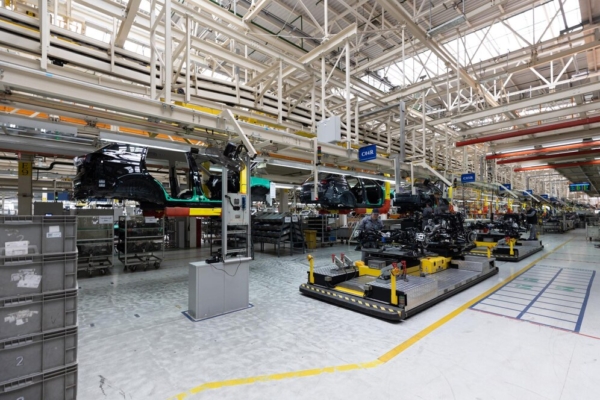Sustainability is at the forefront of the global economy, and as the impacts of climate change continue to be felt worldwide, countries have set new agendas that prioritize sustainable practices in both the public and private sectors. Lucrative government contracts hang in the balance. Companies that align well with national sustainability objectives will be more likely to secure the best deals going forward. What does this mean for the automotive manufacturing sector, and how can your business adapt?

New Horizons in Developing Sustainable Automotive Manufacturing
Sustainability Is Gaining Importance
Around the world, sustainability has been in focus for well over a decade. The United Nations published a series of Sustainable Development Goals back in 2015. Companies have since embraced Environmental, Social and Corporate Governance (ESG) ratings and consulting to improve their standing in regard to sustainability. The influx of money in ESG and sustainability in general sends a clear message: If you want your company to be competitive going forward, it needs to be sustainable.
National agendas have provided more specific guidance for companies in their territory. For instance, in 2016, Saudi Arabia published its Vision 2030 plan for the future of the country. Vision 2030 calls for a Circular Carbon Economy, along with a significant expansion in automotive manufacturing. The country hopes to reach domestic production levels of over 400,000 vehicles per year. If sustainability hasn’t been a priority for your business, it absolutely needs to be.
Pillars for Sustainable Manufacturing
Every business sector has a different road to sustainability. When it comes to manufacturing, there are several key pillars to consider. Environmental impact is often the first point that comes to mind. A sustainable manufacturer minimizes or offsets its environmental impact. However, sustainability is about much more than the environment. It also includes a social component that involves the wellbeing of your employees and their growth. In addition, there’s an important economic dimension to consider.
That last point is often why small and medium businesses avoid pursuing sustainable practices. Sustainability is often seen as more expensive. However, the economic benefits of sustainable manufacturing far outweigh the costs. New approaches to manufacturing and product management can help. Consider how to tackle each of these dimensions within your manufacturing business.
Environmental Factors
To improve your environmental sustainability, you need to look for ways to reduce resource consumption. Start by looking for ways to cut back on raw materials. Raw materials typically represent 30-45% of a manufacturer’s environmental impact, so addressing this area first will yield the best results. Can you reconfigure your manufacturing processes to reduce cuttings, or improve yield quality to reduce waste from failed production?
Adopting techniques like additive manufacturing can yield significant savings, since this approach greatly minimizes raw material waste. However, even subtractive processes can become more efficient by capturing and recycling waste. This can lead to cost savings as you reduce your spending on raw materials. Furthermore, it can help your company remain productive during supply chain disruptions.
Target Energy Efficiency
Energy consumption is the 2nd-largest environmental factor to consider for automotive manufacturing businesses. Upgrading equipment can improve efficiencies, as newer machines can deliver more work with less power. However, you can also make your existing equipment operate more efficiently by implementing predictive maintenance. Instead of performing routine maintenance that may overlook equipment that is nearing failure, predictive maintenance allows you to target machines as they slip out of spec.
Embrace renewable energy on site as well. Solar panels are cheaper than ever. Covering your facility’s roof can easily pay for itself in a few years. Implementing energy recapture systems can likewise lower your energy consumption. For instance, waste heat capture can reuse energy for thermal processes or water heating.
The Social Dimension
Sustainability includes social sustainability. What does this dimension include? Your company should strive to pay its workers well so that they can have sustainable lives. In addition, you should invest in training and education for your staff so that they can grow and develop. Although this may sound prohibitively expensive given that payroll tends to be one of the largest expenses in any business, the rewards are worth it.
By being a socially sustainable company, you can attract better talent, both domestic and foreign. You’ll retain employees longer, which improves productivity and efficiency over the long term as your team becomes better at executing your company processes. Outside your organization, engaging in social projects that uplift the wellbeing of your local community can position your company as a leader and improve your brand image.
Economics: Ensuring Financial Sustainability
None of the aforementioned sustainability objectives are possible if you can’t keep your company’s balance sheet in the black. Economic sustainability has always been a priority for companies, so what has changed? The key difference today is that economic sustainability is dependent on the other pillars of sustainability.
Companies that don’t address their environmental and social responsibilities will find themselves left behind as investors flock to more sustainable enterprises. As more countries adopt policies that promote sustainability, public funding will dry up for businesses that fail to comply. By making it a priority now to implement more sustainable practices, you’ll be well positioned financially for the future.
Digitize Your Business for a More Sustainable Future
If you have yet to develop a plan for making your company more sustainable, where should you begin? For your efforts to be most effective, you’ll need lots of data. The more you can measure your company’s resources, energy usage, social impact, and financials, the more accurately you can address weaknesses and fortify strengths. With a complete digital transformation, you can take a vital first step towards sustainability.
Contact SAAB RDS to learn more about how we can help your company go digital and adopt more sustainable processes.
